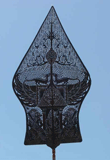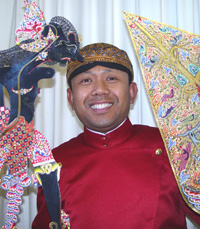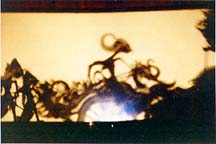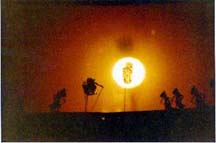|
||||||||||||||||||||||
|
Wayang Sandosa by Joko Susilo Sandosa is an experimental shadow puppet performance that was first performed by the Department of Puppetry (Jurusan Pedalangan) STSI Surakarta, Indonesia. A large 10 by 5 metre screen is used for this kind of performance. A variety of coloured lights are placed behind the screen to enhance the various moods of the scenes. There may be more than ten puppeteers manipulating the puppets. The puppeteers stand, squat, run and walk with their puppets in order to utilise the large screen. Several puppeteers (both male and female) perform the dialogues and narrations and two people control the lights. The Sandosa performance is accompanied by live gamelan (usually in pelog scale). The puppet movement of Sandosa is rather different from that of all-night shadow puppet performance where the puppets generally touch the screen. The function of the screen in all-night shadow puppet performance is, therefore, both to create shadows and act as a support for the puppets to lean against when they are placed in the banana trunk, or are being held by the puppeteer. In a Sandosa performance the puppets may be moved between the screen and the central light (about 5 metres) depending on the size of the shadow required, however, puppets rarely touch the screen. There is no banana trunk in Sandosa performance, puppeteers need to hold the puppets and adjust the size of the shadow by moving the puppet closer to or further away from the light. In Sandosa performance the screen is never empty. The most difficult movements to perform in a Sandosa performance are those of a battle scene in which the puppeteer has to manage the puppets him/herself with no screen or tree trunk support and no assistant who sits behind the puppeteer and prepares the next puppet to appear on screen (as in The understanding and cooperation between puppeteers is very important during Sandosa performance as they negotiate the space and work together behind the screen. |
||||||||||||||||||||||







 all-night performance). The puppeteers must manipulate the puppets above their heads to prevent their shadows from appearing on the screen. Some characters have two metre long handles for certain movements such as flying, dreams or scenes set in the heavens. In a Sandosa performance each puppeteer may have more than three different characters to dramatise.
all-night performance). The puppeteers must manipulate the puppets above their heads to prevent their shadows from appearing on the screen. Some characters have two metre long handles for certain movements such as flying, dreams or scenes set in the heavens. In a Sandosa performance each puppeteer may have more than three different characters to dramatise.